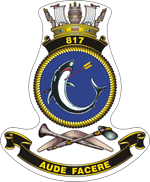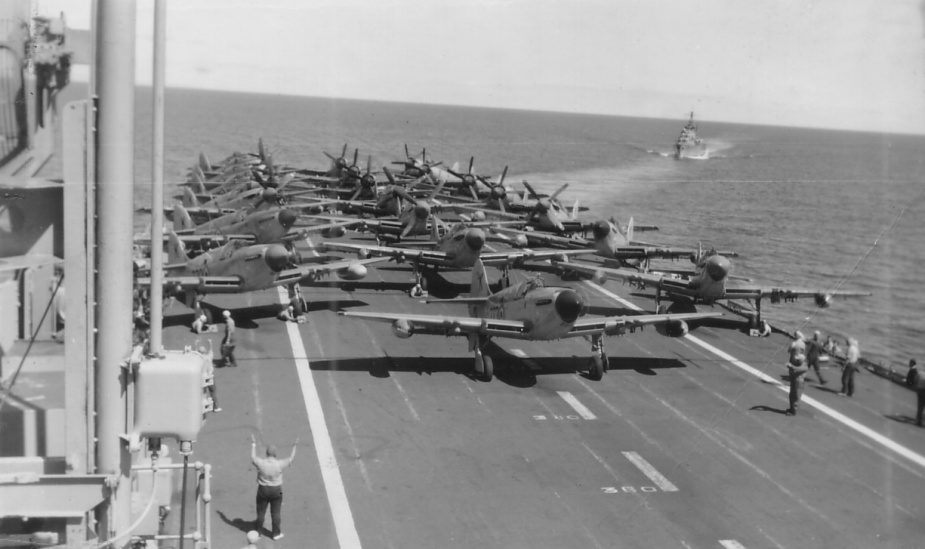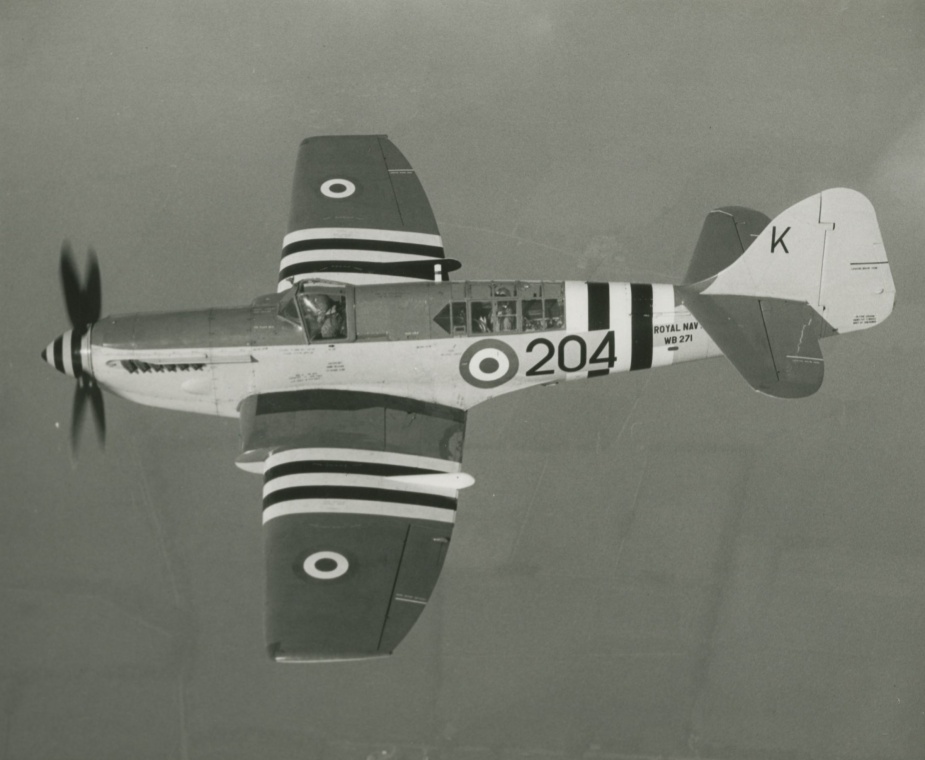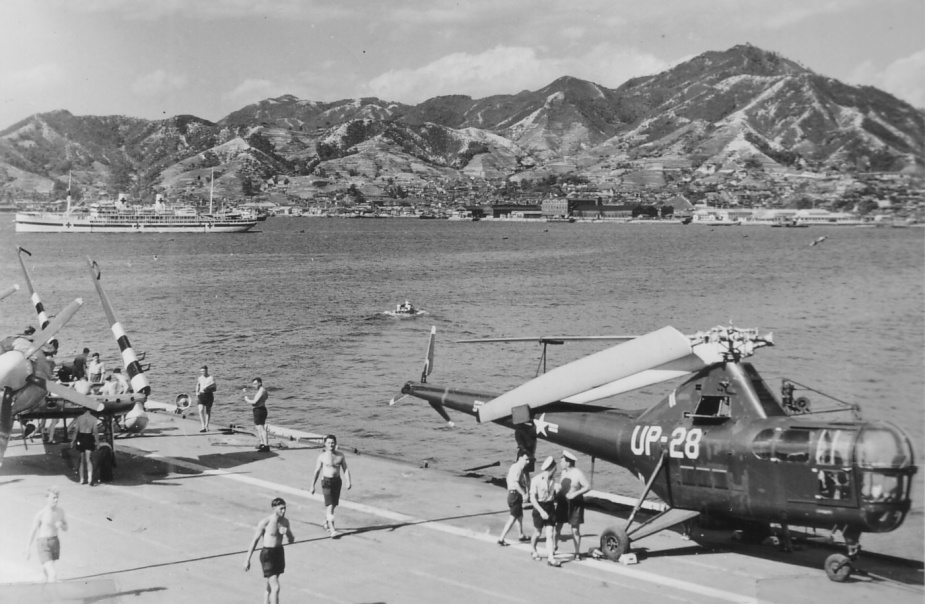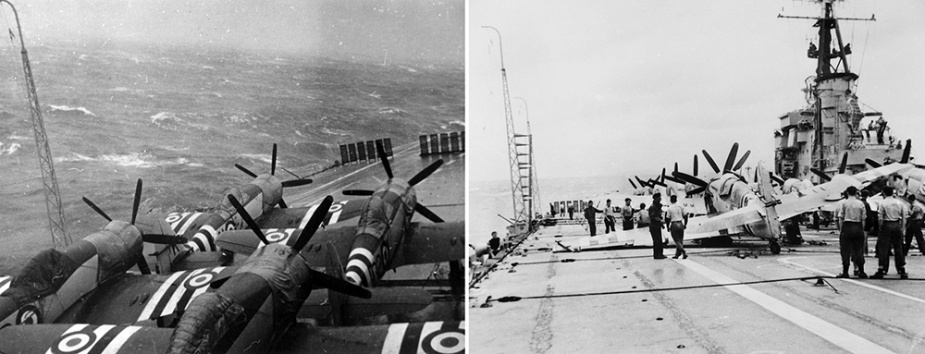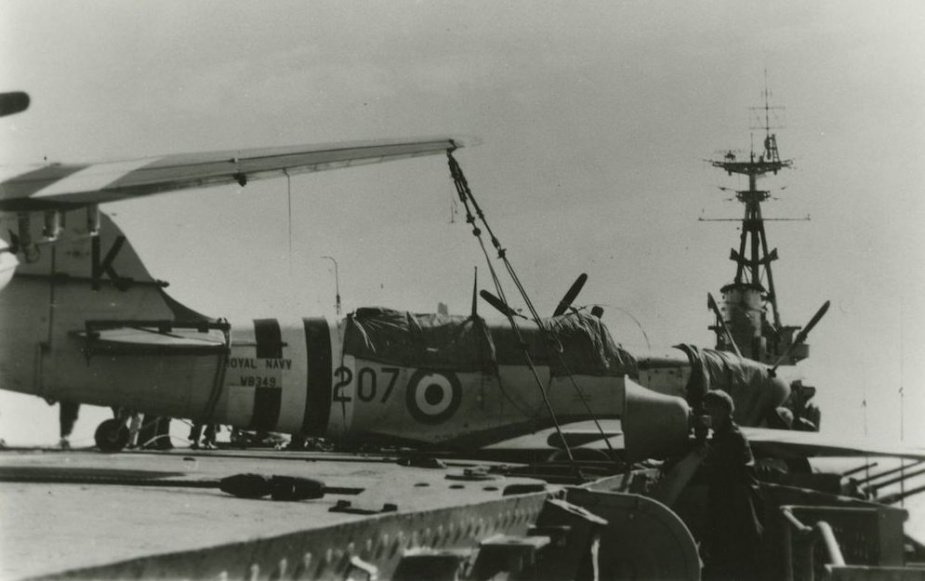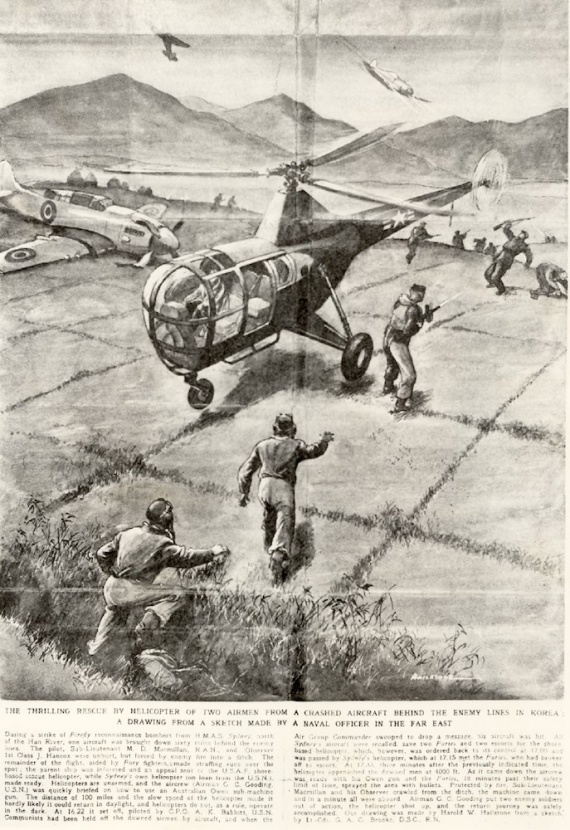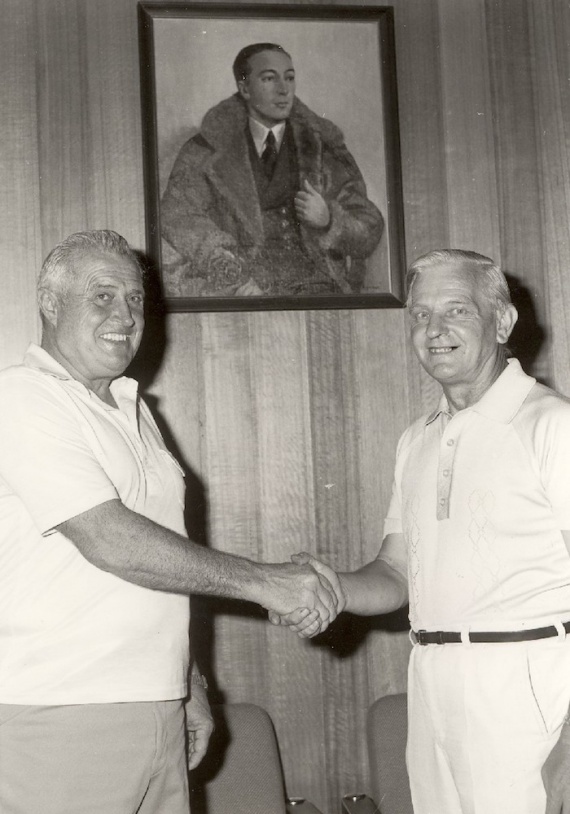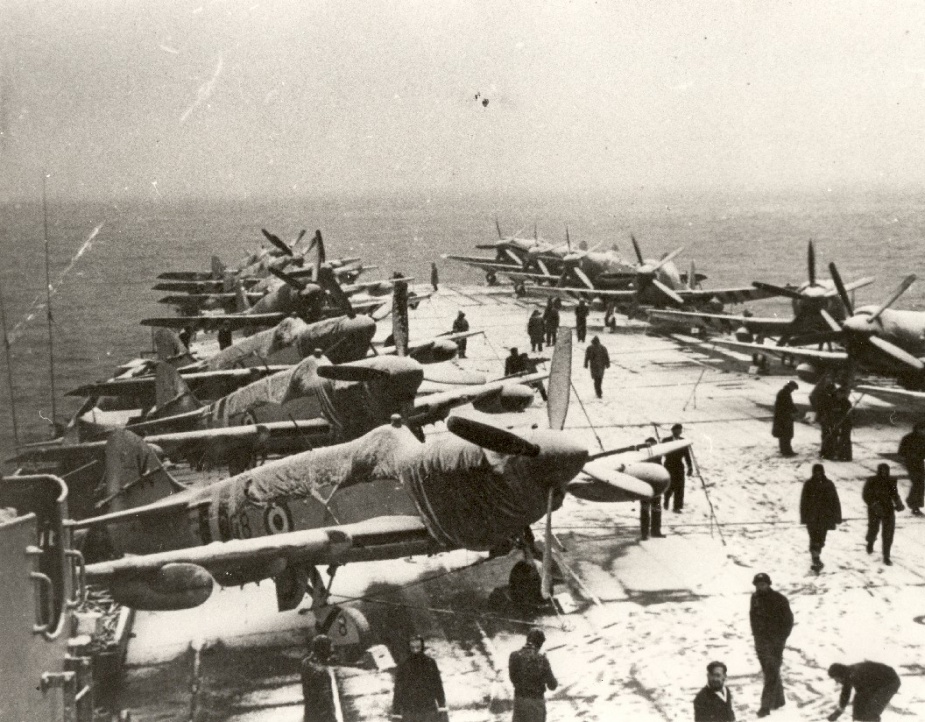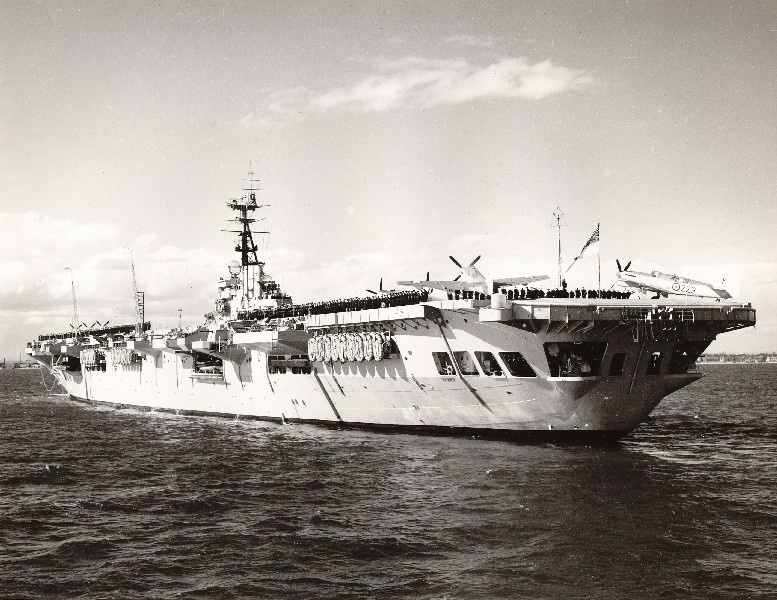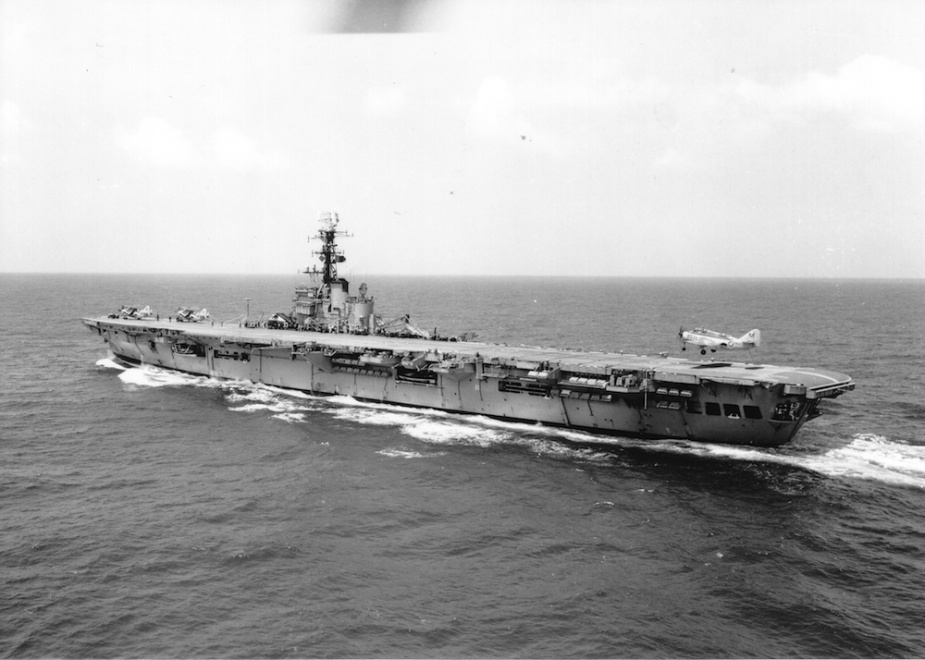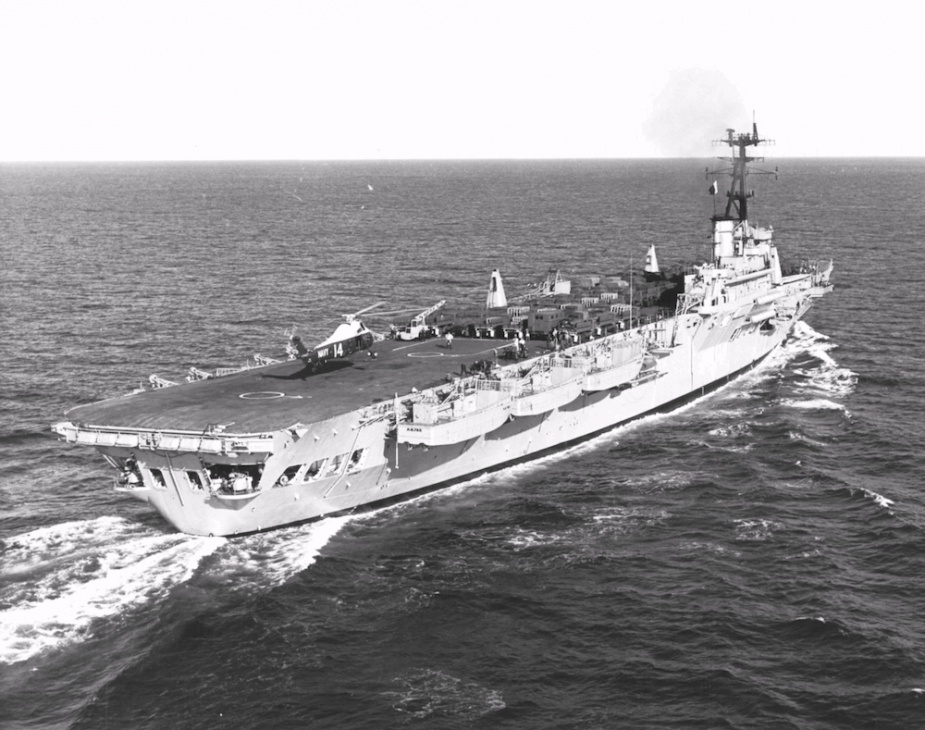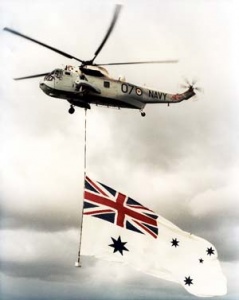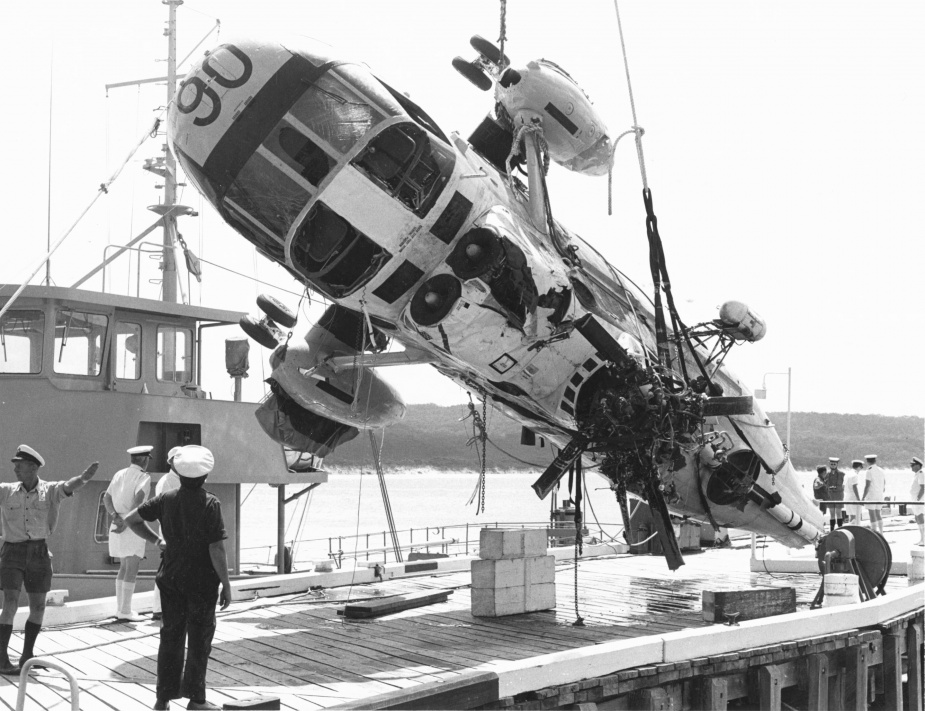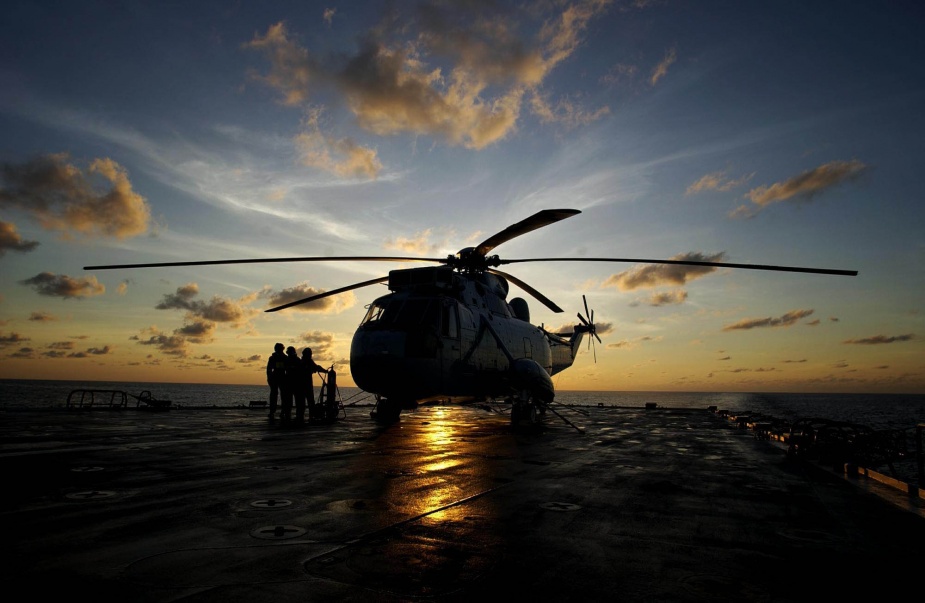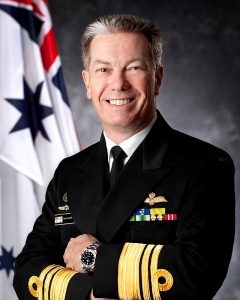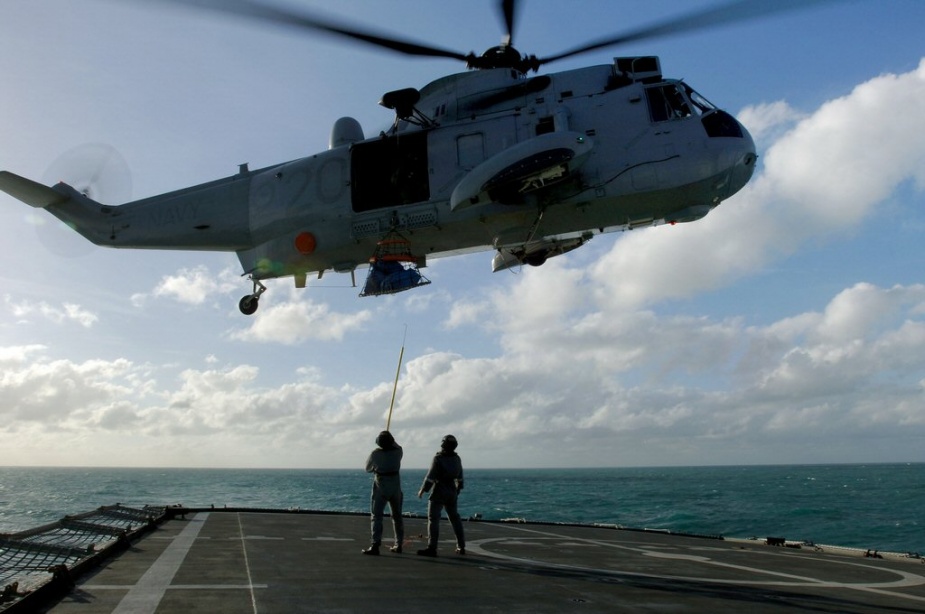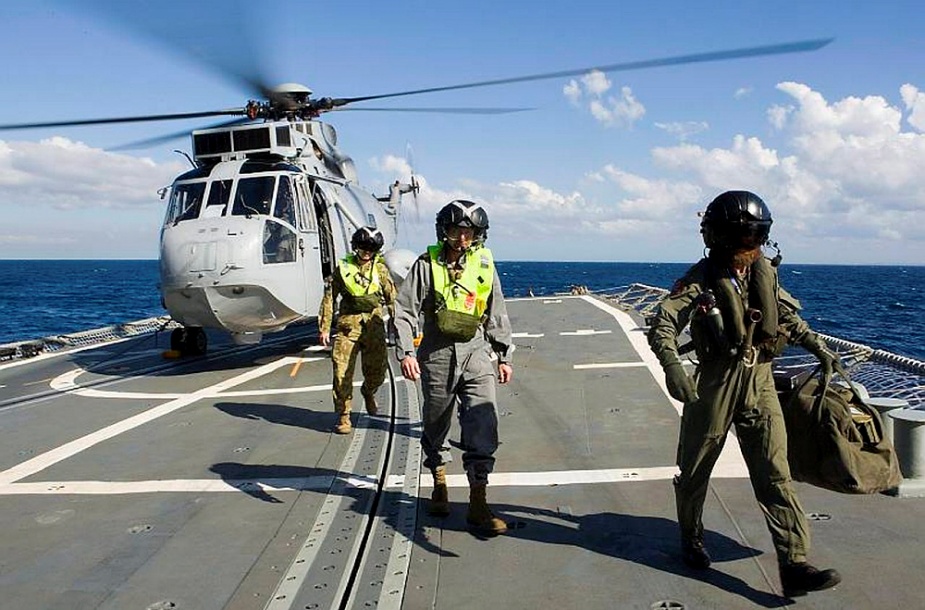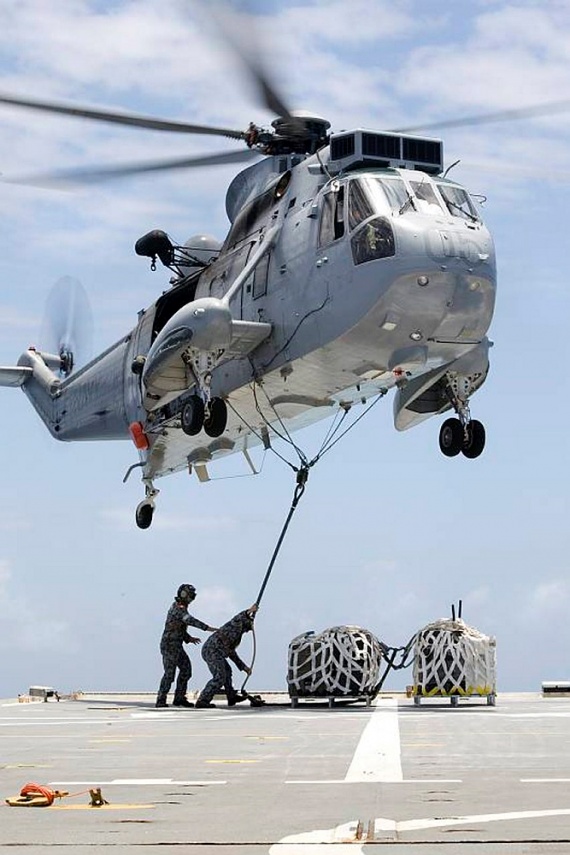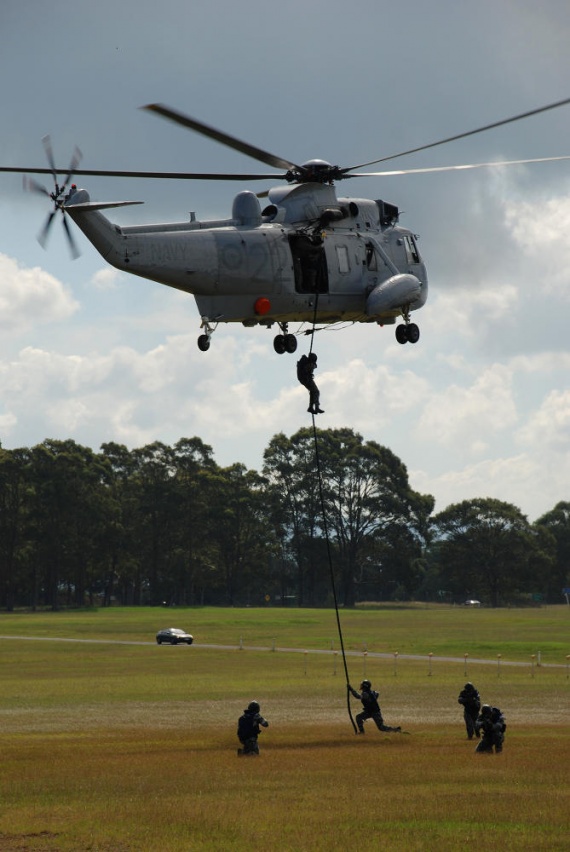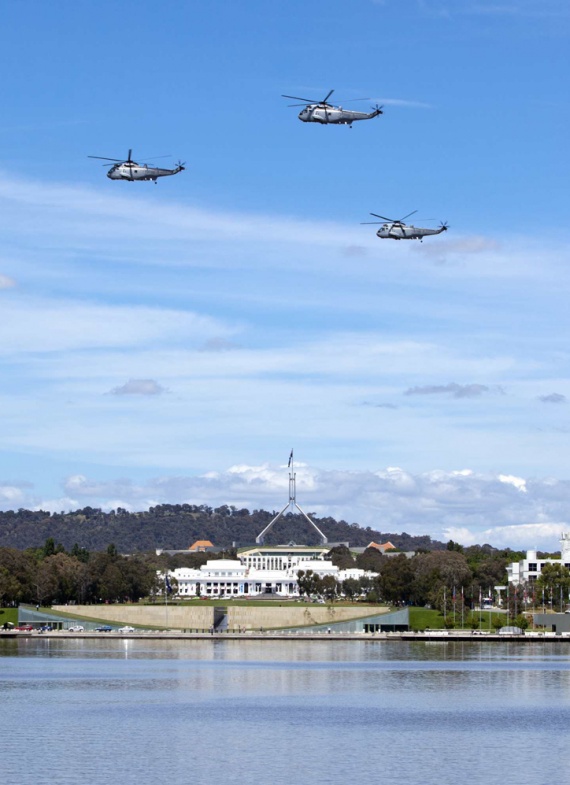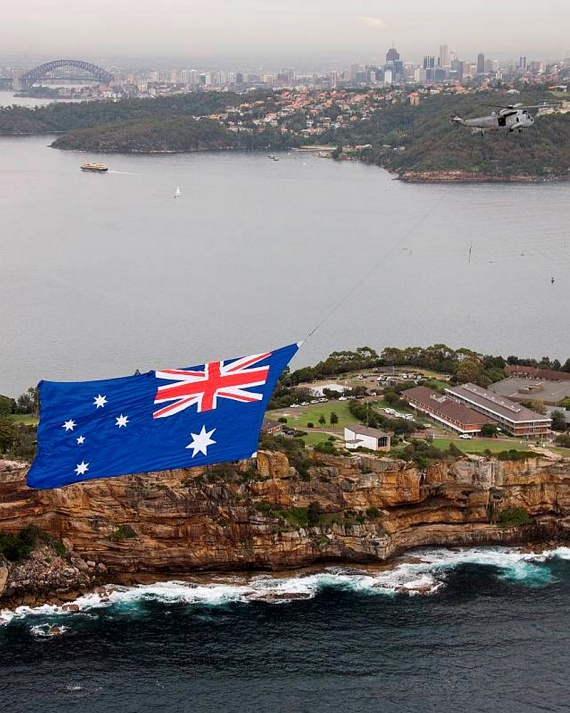817 Squadron History
817 Squadron has its origins in the Royal Navy (RN) where it was commissioned as a torpedo/reconnaissance squadron at Royal Naval Air Station (RNAS) Crail, Scotland on 15 March 1941. The Squadron served in Norway, Biscay, North Africa and Sicily primarily as a patrol unit for anti-submarine operations but was also used for torpedo and bombing missions against enemy ports and shipping. The Squadron disbanded on 23 August 1945.
817 Squadron recommissioned as a Royal Australian Naval Air Squadron at RNAS St Merryn, Cornwall on 25 April 1950. Equipped with Fairey Firefly AS.6 aircraft and commanded by Lieutenant Commander Ronald Lunberg, RN, 817 Squadron formed part of the 21st Carrier Air Group (CAG) along with 808 Squadron. The CAG embarked in the aircraft carrier, HMAS Sydney (III) in October and disembarked at Jervis Bay in December.
21st CAG began carrier qualifications aboard Sydney in April 1951. On 14 May, 817 Squadron were advised that they, along with 805 and 808 Squadrons, would form part of a new Sydney Carrier Air Group under the command of Commander (later Vice Admiral Sir) Mike Fell, RN, and deploy to Korea later that year. New pilots, many straight out of training, hurriedly converted to local operating procedures and the squadron's aircraft, Firefly AS.6s, had to be replaced temporarily with AS.5 aircraft borrowed from 816 Squadron and the Royal Navy. The reason for this was that the AS.6 model Firefly did not have any guns whereas the AS.5 did. The AS.5's guns were considered necessary for the types of operations that the Fireflies would be undertaking in Korea, a consideration which was subsequently proven to be correct. 817 Squadron departed for Korea aboard Sydney on 31 August 1951. Sydney arrived in Japan on 19 September and prepared for a handover from HMS Glory. The aircraft of the Sydney CAG now bore black and white markings signifying that they were on operations with the United Nations (UN).
Participating in Operation STRANGLE, which was intended to cut enemy supply and communications to the front lines, Sydney shared patrol duties on Korea's west coast with RN and US Navy (USN) carriers as part of Task Force 95, United Nations Blockade and Escort Force. Seven patrols of roughly 13 days duration, including four days in transit to and from bases in Japan, were originally planned. Operations normally entailed ground attack including close air support for ground forces, armed reconnaissance, spotting for ships guns and anti-shipping strike missions. In addition, the CAG maintained a Combat Area Patrol (CAP) during daylight hours to protect Sydney in the event of an enemy air attack.
Sydney's CAG launched its first air strikes on 5 October 1951. It did not take long before the squadron earned a reputation as being a proficient strike unit having carried out a number of very successful missions against rail and road bridge targets. Rail and road interdiction became the main role of the squadron throughout the Korean War and this often required the pilots to use low level attacks against heavily defended targets behind enemy lines. Anti-aircraft fire was particularly effective under these circumstances and several Fireflies were lost or damaged as a result. Anti-submarine patrols were also flown by 817 Squadron around the Sydney task group and spotting tasks were also conducted for ships involved in Naval Gunfire Support off the Korean coastline.
Just six days after flying its first sorties, on 11 October, Sydney's CAG achieved a light fleet carrier record of 89 sorties in one day conducting attacking raids and targeting sorties for USS New Jersey. This exceptional performance drew high praise from the British Commander-in-Chief Far East Station:
Your air effort in the last two days, unprecedented in quantity and high in quality, has been a magnificent achievement on which I warmly congratulate you. Though it is invidious to particularise - the spotters especially did a first class job and New Jersey with [the Commander of the] 7th Fleet embarked said they were the best she has had yet. Eighty-nine sorties in one day is grand batting by any standards, particularly in the opening match...
Aircraft engineers and maintenance crews also won much well deserved praise achieving remarkable serviceability and turn-around rates to keep the aircraft flying. Ordnance crews were also required to load armaments of up to 227kg in all weather, day and night.
On 14 October, 817 Squadron's personnel were subjected to the full force of Typhoon Ruth. Battling an estimated force 12 sea at its height, and with waves up to 45 feet high crashing over her deck, Sydney rode out the storm at sea with 13 of her aircraft exposed on deck. It was hardly surprising that five of them were written off with at least one being washed over board. The carrier itself sustained damage and several of her personnel suffered minor injuries.
During flying operations on 25-26 October, three of Sydney's aircraft were shot down and a fourth badly damaged. One of these, a Firefly from 817 Squadron, piloted by Sub Lieutenant Neil MacMillan and Chief Petty Officer Phillip Hancox was forced down in a frozen rice paddy 50 miles behind enemy lines. The two downed aviators resisted capture by enemy soldiers with the aid of an Owen sub machine gun and a protective overhead umbrella provided by Sea Furies from Sydney and Meteor jet fighters from the Royal Australian Air Force's (RAAF) 77 Squadron. The two airmen were later rescued by Sydney's Dragonfly helicopter which had flown 172 kilometres to carry out the rescue at the limit of its fuel endurance. It then recovered to Kimpo airfield where upon landing it was unable to taxi having run out of fuel. It returned to Sydney with its passengers the following day. The helicopter pilot, Chief Petty Officer Arlene 'Dick' Babbit, USN, was awarded the Commonwealth Distinguished Service Medal as well as the United States Navy Cross for his efforts that day, earning the distinction of being the only allied serviceman in Korea to receive the awards of two nations for the same action. His aircrewman Machinest Mate 3rd Class Calllis Gooding shot dead a North Korean soldier as MacMillan and Hancox scrambled into the helicopter and Gooding was later awarded the US Navy Cross for his bravery during this rescue.
With the onset of the Korean winter, flying operations became increasingly difficult for both the aircrew and maintainers of 817 Squadron. The icy conditions and subzero temperature on Sydney's windswept, and at times, snow covered flight deck resulted in a number of cases of frostbite and introduced the additional hazard of aircrew freezing to death if an aircraft was forced to ditch at sea.
Sydney's last raids were scheduled for 25 January 1952, striking directly on the North Korean capital of Pyongyang. Extremely poor weather, however, caused the mission to be cancelled and Sydney returned to Australia a few days later via Sasebo and Hong Kong.
Collectively, Sydney's CAG had flown 2366 sorties for the loss of three lives (all from 805 Squadron) and 14 aircraft (five of which were lost overboard or damaged beyond repair by Cyclone Ruth). Sydney had achieved an enviable operational record in Korea and it was noted that enemy activity decreased significantly in Sydney's area of operations.
Sydney arrived in Fremantle on 22 February 1952 in the middle of industrial unrest on the waterfront. Union action meant that no tugs arrived to pull Sydney out of the harbour on its departure date 3 days later. In response, the ship initiated an action known as Operation PINWHEEL whereby the Sea furies of 805 and 808 Squadrons started the engines of the aircraft sitting on Sydney's flightdeck and used their thrust to pull the carrier clear.
That October, Sydney participated in Operation HURRICANE the name given to the British nuclear tests in the Monte Bello Islands off the north west coast of Western Australia. 817 Squadron, along with 805 Squadron, enforced a security radius of 72 kilometres around the test site.
The tests successfully concluded, Sydney returned to NAS Nowra that November before sailing for Queen Elizabeth II's Coronation Fleet Review in England in March 1953 with 817 Squadron embarked. Flying opportunities were limited on the trip though the Squadron did participate in exercises with the Mediterranean Fleet and with Canadian warships in the Atlantic Ocean on the voyage back to Australia. The Coronation featured some 229 ships from around the world and the flypast, which included the Fireflies of 817 Squadron, was made up of over 300 aircraft from 37 squadrons. Sydney returned to Australia in August and visited Canada, the United States, the West Indies, Panama, and New Zealand on her voyage home.
817 Squadron embarked for short time aboard HMAS Vengeance before decommissioning on 27 April 1955 at NAS Nowra. The Squadron recommissioned four months later on 23 August 1955 at RNAS Culdrose in Cornwall, England equipped with Fairey Gannet AS.1 anti-submarine aircraft. The Squadron participated in the flying trials for the RAN's new aircraft carrier, HMAS Melbourne (II) and embarked in Melbourne for the carrier's journey to Australia in March 1956, arriving in Fremantle on 23 April. The carrier disembarked most of its aircraft at Jervis Bay the following month before arriving in Sydney Harbour, with much fanfare, on 9 May 1956. The Squadron participated in various exercises before decommissioning again on 18 August 1958.
On 18 July 1963, 817 Squadron again reformed at NAS Nowra this time equipped with Westland Wessex 31A anti-submarine helicopters. The Squadron embarked in Melbourne later in the year where the Wessex proved an instant success. Its dunking sonar made them the most effective submarine detecting aircraft yet seen in the RAN.
The Squadron continued embarked operations in Melbourne until the carrier's modernisation programme began, after which an element embarked in Sydney for anti-submarine escort duties during troop transport voyages to Vietnam, a responsibility it shared with 725 Squadron. While in the operational area, the normal routine was to have one Wessex screening the ship while another was fully armed and prepared on her deck. In addition to its Anti-Submarine Warfare (ASW) responsibilities, 817 Squadron also provided guard helicopters during the launching and recovery of Melbourne's fixed wing aircraft and also provided civil aid services when operating from NAS Nowra.
Early in 1969 the Squadron re-equipped with the more capable Westland Wessex Mk31B helicopter and re-embarked in Melbourne providing anti-submarine protection to the fleet. In May that year, Melbourne, with her new CAG made up of 805, 816 and 817 Squadrons (flying McDonnell Douglas A-4G Skyhawks, Grumman S-2E Trackers and Wessex helicopters respectively), departed Australia for the successful 'Sea Sprite' SEATO exercises in South East Asia. The exercises, however, were marred by a tragedy involving Melbourne. At 3:15am on 3 June 1969, Melbourne collided with USS Frank E Evans recalling the HMAS Voyager (II) disaster five years earlier. No one in Melbourne was hurt but the American destroyer lost 74 lives. A number of Melbourne's crew were decorated or commended for their actions on the night of the collision including Lieutenant Commander Des Rogers, 817 Squadron's Commanding Officer, who received the Air Force Cross for his efforts and the performance of his Squadron. The Squadron also received a Meritorious Unit Commendation from the US Secretary of the Navy. Lieutenant Commander Col Patterson, Melbourne's Flight Deck Officer, received a Member of the British Empire for his courage in the rescue operations which included boarding the US Destroyer's aft section and searching it for survivors. Melbourne made for Singapore for temporary repairs before departing for Australia and a new bow section. The CAG remained operational in spite of the extensive damage. A subsequent inquiry cleared Melbourne of any blame.
Shortly afterwards, the Fleet Air Arm (FAA) adopted United States Navy (USN) pre-fixes and 817 Squadron became HS817 Squadron indicating that it was a rotary wing, anti-submarine unit.
The Squadron and its Wessex helicopters were called into action in 1975 to assist in relief efforts for one of the most devastating natural disasters in Australian history. Melbourne was alongside in Sydney with her CAG disembarked at NAS Nowra when Cyclone Tracy hit Darwin on Christmas Eve 1974. HS817 Squadron personnel were recalled, leaving their homes and loved ones at Christmas time, to begin relief efforts in the northern capital. Melbourne arrived in Darwin on 2 January 1975 and HS817 Squadron's helicopters made an immediate impact on Operation NAVY HELP DARWIN. The Squadron was able to conduct search and rescue sorties in areas that had previously been inaccessible enabling evacuations to be carried out quickly and over great distances. Darwin's mayor, Harry 'Tiger' Brennan, later said "We owe the Navy the greatest debt of all".
The Wessex had been an impressive ASW aircraft performing admirably in civil service operations for nearly a decade but rapid technological advancements meant that the search for a replacement was in full swing by the early 1970s. The Westland Sea King Mk 50 anti-submarine helicopter was chosen as the Wessex replacement and a detachment from 817 Squadron was consequently sent to the UK to undergo conversion training at RNAS Culdrose as early as October 1974.
Conversion training from Wessex to Sea Kings continued throughout 1975 in Australia and during one such flight the inherent dangers of flying were highlighted when on 21 October 1975, Sea King 906 was lost in Shoalhaven Bight approximately 6 nm east of Grenwell Point. The crew comprised Lieutenant Commander C Daley, RAN,( Pilot) Lieutenant G Rogers, RAN, Lieutenant D Morehouse, RAN and Lieutenant I Misfelt, RAN. On that occasion two Sea Kings were conducting conversion training and night winching operations over water which necessitated Lieutenant Morehouse, in the rear of Shark 06, visually reporting his aircraft's hover approach to a smoke marker with the rear cabin door open. As he was performing this duty he was doused with hot oil flowing down the outside of the aircraft from the main rotor gearbox platform. The loss of oil was immediately reported to the aircraft's captain and the cabin door secured. The pilot gained height at the same time declaring a PAN as his instruments confirmed the loss of oil pressure. Moments later the aircraft lost all torque indicators and Lieutenant Commander Daley was faced with little option other than to conduct a controlled ditching. NAS Nowra and the other Sea King were informed and shortly afterwards the aircraft ditched, shearing off the rotor blades before turning over and sinking nose first. The cabin rapidly filled with water and the crew inside was fortunate to escape. They were then recovered by the second Sea King and taken back to NAS Nowra. Lieutenant Morehouse was to later attribute his survival to helicopter escape training he had received while undertaking flying training in the US at NAS Pensacola. As a result of this Helicopter Underwater Escape Training (HUET) later became mandatory for RAN aircrew. The aircraft's loss was investigated and subsequently attributed to a sub-standard gear box design. Three further Sea Kings were to fall victim to similar gearbox failures.
By 2 February 1976, the Squadron was fully equipped with Westland Sea King Mk 50 and the Wessex subsequently took on a secondary role as a utility aircraft conducting plane guard and search and rescue duties. They continued to serve in the RAN for a further 13 years.
When HMAS Melbourne (II) decommissioned in 1982, HS817 Squadron operated permanently from NAS Nowra as the Sea King was prohibitively large for regular embarked operations. The Squadron did, however, embark in HMA Ships Stalwart, Jervis Bay, Success, Tobruk, Kanimbla and Manoora throughout the 1980s and 1990s, and a flight continues to embark in the replenishment ship HMAS Success to this day.
With the recommissioning of 816 Squadron in July 1992 and the introduction into service of the Sikorsky S-70B-2 Seahawk anti-submarine helicopter, HS817 Squadron's Sea Kings assumed the role of a utility helicopter. Although primarily an anti-submarine weapons system, the Sea King took on a diverse range of activities. In this capacity they have seen active service in East Timor and the Persian Gulf and served in numerous other operational areas including Somalia, Bougainville and the Solomon Islands. The Squadron has also become central in RAN ceremonies and has regularly been seen flying flags for more than 20 years at events such as the RAN's 75th Anniversary commemorations in 1986 and Bicentennial celebrations in 1988.
Throughout the 1990s, HS817 Squadron performed a number of civil aid tasks exemplifying the Sea King's value as a utility aircraft. In April 1990, Sea Kings deployed to Dubbo in NSW to assist in flood relief operations around Nyngan. Early in 1992, the Squadron was supporting fire crews fighting bushfires around Nowra and barely four months later were again involved in flood relief operations in the same area. The Sea Kings were again involved in fire fighting efforts, carrying large buckets of water to bush fire affected areas during the devastating fires in NSW in 1994.
In 1995, the Sea Kings began a major modernisation program, the first such upgrade since the aircraft had entered service with RAN some 20 years earlier. Following the upgrade, the Sea Kings were officially tasked in a utility role.
The success of the HS817 Squadron's fire fighting efforts in 1994 meant that the Sea Kings have continued to be utilised in that role, most notably in 1998 on largely inaccessible bushfires on the NSW-Victorian border and again in 2003 in Southern NSW and the ACT.
On 2 April 2005 disaster struck 817 Squadron when it lost one of its Sea Kings during Operation SUMATRA ASSIST 2, a relief operation providing assistance to the people of Indonesia following the devastating earthquakes of 28 March 2005. The Sea King (call-sign 'Shark 02') launched from HMAS Kanimbla in response to a report that villagers in Amandraya on the island of Nias were in urgent need of medical assistance. The aircraft had on board a full crew and Air Medical Evacuation (AME) team and concerns were raised when communications were lost between it and another Sea King operating in the area, 'Shark 21'.
Sadly, Shark 21 subsequently reported that Shark 02 had crashed at the village of Amandraya. Nine of the Sea King's crew were killed in the crash and two personnel were seriously injured (http://www.defence.gov.au/sea_king_boi/memorial.htm). This was a devastating blow to the close knit 817 Squadron and Naval Aviation community.
From December 2007, the Squadron started a replacement program with the first of the new NH Industries utility helicopters arriving in the RAN. As well as facilitating the introduction of this new aircraft type, the Squadron continued to support RAN operations and exercises, such as Operations RESOLUTE and SLIPPER, and Exercise RIMPAC, as well as supporting various public relations exercises.
On 30 September 2009, the region around Padang on the Indonesian island of Sumatra was devastated by a 7.6 magnitude earthquake killing over 1000 people and destroying the homes and livelihoods of hundreds of thousands. Two Sea King helicopters, their crews and maintainers embarked in HMAS Kanimbla on 6 October 2009 to contribute to Operation PADANG ASSIST, the Australian response to the disaster. The Sea Kings were used for aerial reconnaissance, transport of shore parties and equipment, and remained on standby for medical evacuation. Kanimbla arrived back in Australia on 5 November 2009.
The Squadron was again called into action to provide assistance in a disaster zone, on this occasion within Australia, when Queensland and northern New South Wales were devastated by flood waters at the beginning of 2011. At 3:00am on 11 January, the crews of the Joint Task Force’s two Sea Kings, Shark 21 and Shark 22, began preparations to fly from Oakey Air Base to RAAF Base Amberley to assist with evacuations in the Lockyer Valley. Over the course of the day, the two aircraft rescued nearly 200 people from the rapidly rising flood waters.
The Squadron farewelled it’s adopted home town of Goolwa, South Australia, in the last week of February 2011 conducting school visits, flying displays, a freedom of entry parade on 26 February and a rededication of the 817 Squadron memorial at the Goolwa RSL sub-branch, honouring those who have lost their lives while serving with the Squadron. Three Sea Kings also participated in Exercise TALISMAN SABRE 2011 in July, the Squadron’s final major exercise before decommissioning.
Three Sea Kings performed the Squadron’s final ceremonial flyover on 15 December 2011, flying over Sydney and Canberra before returning to HMAS Albatross for the last time. The Squadron decommissioned, and the Sea Kings paid off, the following day. One Sea King remains at Albatross, on display at the Fleet Air Arm Museum.
Chronology of 817 Squadron history
|
Chronology
|
Event
|
| 15 Mar 1941 | Formed as 807 Squadron RN |
| 23 Aug 1945 | Disbanded |
| 25 Apr 1950 | Commissioned at St Merryn, UK with Fairey Fireflies for service in HMAS Sydney as part of 21st Carrier Air Group |
| 31 Aug 1951 | Departs Australia for Korean War |
| 11 Oct 1951 | Sets light fleet carrier record by flying 89 sorties in one day |
| 27 Jan 1952 | Tour in Korea ends |
| 30 Mar 1953 | Departs Australia for Coronation Fleet Review |
| 14 Aug 1953 | Returns to Australia from Coronation Fleet Review |
| 27 Apr 1955 | Decommissioned at NAS Nowra |
| 23 Aug 1955 | Recommissioned at RNAS Culdrose, UK with Fairey Gannets |
| 18 Aug 1958 | Decommissioned at NAS Nowra |
| 18 Jul 1963 | Recommissioned at NAS Nowra with Westland Wessex helicopters |
| 03 Jun 1969 | HMAS Melbourne collides with USS Frank E Evans killing 74 US sailors. 817 Squadron receives a commendation for its part in search and rescue efforts |
| 24 Dec 1974 | Cyclone Tracy hits Darwin. HS817 Squadron assists in the relief effort from HMAS Melbourne |
| 02 Feb 1976 | Squadron fully re-equipped with Westland Sea King helicopters |
| 30 Jun 1982 | HMAS Melbourne decommissioned. HS817 Squadron moves to NAS Nowra |
| 02 Apr 2005 | Sea King 'Shark 02' crashes on the island of Nias, Indonesia killing nine of its crew and injuring two others |
| 18 Dec 2007 | Begins taking delivery of MRH90 utility helicopters |
| 06 Oct 2009 | Two Sea Kings embark in HMAS Kanimbla to contribute to Operation PADANG ASSIST |
| 11 Jan 2011 | Two Sea Kings assist in evacuations from rising flood waters in the Lockyer Valley, Queensland |
| 16 Dec 2011 | Decommissioned at NAS Nowra |
Commanding Officers of 817 Squadron
| Assumed Command | Commanding Officer |
| 25 Apr 1950 | Lieutenant Commander RB Lunberg, RN |
| 14 Jul 1952 | Lieutenant Commander AL Oakley, DFC |
| 15 Aug 1953 | Lieutenant Commander DS Harvey |
| 13 Oct 1953 | Lieutenant Commander JD Goble |
| 04 Aug 1955 | Lieutenant Commander JA Gledhill, DSC |
| 09 Nov 1956 | Lieutenant Commander JS Hickson |
| 07 Jan 1957 | Lieutenant Commander HE Bailey, DSC |
| 18 Jul 1963 | Commander G McC Jude |
| 19 Sep 1963 | Lieutenant Commander RJ Simmonds |
| 04 Oct 1965 | Lieutenant Commander DJ Orr |
| 07 Jun 1966 | Lieutenant Commander F Hillier |
| 26 Jul 1966 | Lieutenant Commander AAH Evans |
| 23 Oct 1967 | Lieutenant Commander RA Waddell-Wood |
| 15 Jan 1968 | Lieutenant Commander DN Rodgers |
| 01 Jul 1968 | Lieutenant Commander GA Thomas, RN |
| 28 Nov 1968 | Lieutenant Commander DS Ferry |
| 16 Mar 1969 | Lieutenant Commander DN Rodgers |
| 05 Jan 1970 | Lieutenant Commander AG Whitton |
| 31 May 1971 | Lieutenant Commander DC MacLaren |
| 26 Jul 1972 | Lieutenant Commander DG Debus |
| 28 Jun 1974 | Lieutenant Commander TSJ Pennington |
| 09 Jun 1975 | Lieutenant Commander IM Speedy |
| 02 Feb 1976 | Commander ES Bell |
| 08 Feb 1976 | Lieutenant Commander RK Waldron |
| 12 Feb 1977 | Lieutenant Commander JW Firth |
| 29 May 1978 | Lieutenant Commander AH Craig |
| 04 May 1979 | Lieutenant Commander KB Englesman |
| 03 Apr 1980 | Lieutenant Commander WM Kimpton |
| 30 Mar 1981 | Lieutenant Commander JWJ Nicoll |
| 21 Jan 1983 | Lieutenant Commander HE Campey |
| 06 Jul 1984 | Lieutenant Commander KW Eames |
| 21 Dec 1984 | Lieutenant Commander RJ Cooper |
| 05 Dec 1986 | Lieutenant Commander LN Phillips |
| 01 Jul 1988 | Lieutenant Commander AF Wright |
| 08 Dec 1989 | Lieutenant Commander T Gorman |
| 06 Jan 1991 | Lieutenant Commander JH Edwards |
| 13 Dec 1993 | Lieutenant Commander PR Lea |
| 05 Apr 1994 | Lieutenant Commander RJ Smith |
| 25 Apr 1996 | Lieutenant Commander TW Barrett |
| 01 Jan 1997 | Commander TW Barrett |
| 05 May 1997 | Lieutenant Commander G Sydney |
| 26 Jun 1999 | Lieutenant Commander DJ Gwyther |
| 01 Jan 2000 | Commander DJ Gwyther |
| 07 Sep 2000 | Commander K MacAuley-Black |
| 09 Oct 2003 | Commander JO Tobin |
| 28 Nov 2005 | Commander TR Leonard |
| 14 Dec 2007 | Commander RI Gagnon |
| 11 Aug 2009 | Commander P Moggach |
Further reading
- 'Flying Stations: A Story of Australian Naval Aviation', Australian Naval Aviation Museum, Allen & Unwin, St Leonards, 1998.
- 'Flying Squadrons of the Australian Defence Force', Steve Eather, Aerospace Publications, Canberra, 1995.
- 'Wings Across the Sea', Ross Gillett, Aerospace Publications, Canberra, 1988.
- 'Wings and the Navy 1947-1953', Colin Jones, Kangaroo Press, Kenthurst, 1997.

